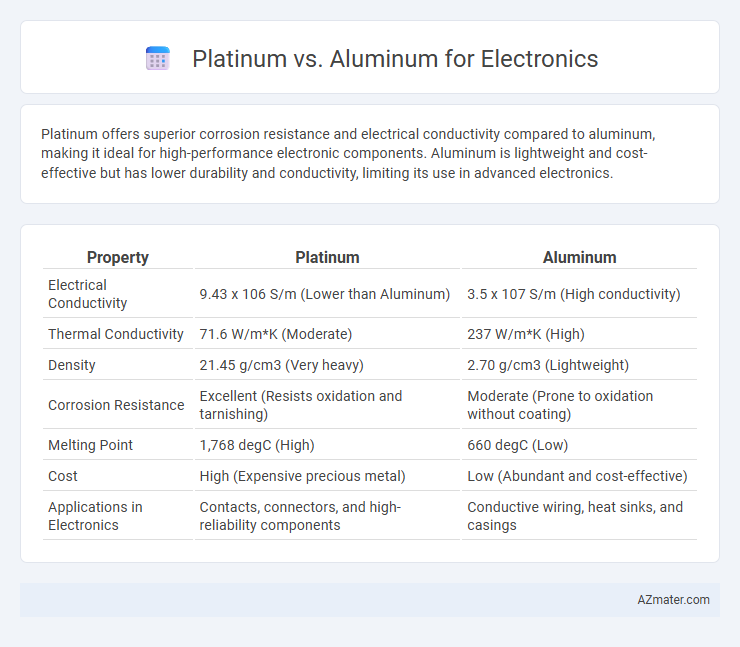Platinum offers superior corrosion resistance and electrical conductivity compared to aluminum, making it ideal for high-performance electronic components. Aluminum is lightweight and cost-effective but has lower durability and conductivity, limiting its use in advanced electronics.
Table of Comparison
| Property | Platinum | Aluminum |
|---|---|---|
| Electrical Conductivity | 9.43 x 106 S/m (Lower than Aluminum) | 3.5 x 107 S/m (High conductivity) |
| Thermal Conductivity | 71.6 W/m*K (Moderate) | 237 W/m*K (High) |
| Density | 21.45 g/cm3 (Very heavy) | 2.70 g/cm3 (Lightweight) |
| Corrosion Resistance | Excellent (Resists oxidation and tarnishing) | Moderate (Prone to oxidation without coating) |
| Melting Point | 1,768 degC (High) | 660 degC (Low) |
| Cost | High (Expensive precious metal) | Low (Abundant and cost-effective) |
| Applications in Electronics | Contacts, connectors, and high-reliability components | Conductive wiring, heat sinks, and casings |
Overview of Platinum and Aluminum in Electronics
Platinum offers exceptional corrosion resistance and stable electrical conductivity, making it ideal for high-performance electronic components such as contacts and connectors in harsh environments. Aluminum is widely used in electronics for its lightweight, excellent thermal conductivity, and cost-effectiveness, commonly found in heat sinks and conductive paths on circuit boards. The choice between platinum and aluminum depends on application requirements, balancing durability and cost with conductivity and thermal management.
Material Properties: Platinum vs Aluminum
Platinum offers superior corrosion resistance and excellent electrical conductivity compared to aluminum, making it ideal for high-reliability electronic applications. Aluminum is lightweight and cost-effective, with good thermal conductivity but lower durability and resistance to oxidation than platinum. The choice between platinum and aluminum depends on balancing performance requirements such as durability, conductivity, and budget constraints in electronic device manufacturing.
Electrical Conductivity Comparison
Platinum exhibits significantly lower electrical conductivity compared to aluminum, with aluminum's conductivity approximately 61% that of pure copper, while platinum's conductivity is about 16% of copper's. This difference makes aluminum a preferred choice in electronics for efficient current flow and lightweight wiring applications. Despite its lower conductivity, platinum offers superior corrosion resistance and stability, beneficial for specialized electronic components where durability outweighs conductive efficiency.
Thermal Conductivity and Heat Management
Platinum exhibits lower thermal conductivity (~71.6 W/m*K) compared to aluminum (~237 W/m*K), making aluminum more efficient for heat dissipation in electronics. Effective heat management in electronic components relies heavily on materials with high thermal conductivity, where aluminum's lightweight properties and excellent heat transfer capabilities enhance performance and longevity. Platinum's superior corrosion resistance and electrical conductivity benefit niche applications but generally fall short in thermal management compared to aluminum.
Corrosion Resistance and Durability
Platinum exhibits superior corrosion resistance compared to aluminum, maintaining stability in harsh environments, including exposure to acids and salts, which makes it ideal for high-reliability electronic components. Aluminum, while lighter and cost-effective, tends to form a protective oxide layer that prevents further corrosion but can degrade under prolonged exposure to moisture and chemicals, potentially compromising electronic durability. The exceptional durability and inert nature of platinum ensure long-term performance in critical electronic applications where material integrity is paramount.
Cost Analysis and Economic Factors
Platinum's high cost, driven by scarcity and complex extraction processes, makes it significantly more expensive than aluminum, which is abundant and cost-effective for mass production in electronics. Aluminum offers excellent conductivity and lightweight properties at a fraction of platinum's price, making it the preferred choice for budget-sensitive applications. Economic factors prioritize aluminum's scalability and affordability, whereas platinum is reserved for niche electronics requiring superior corrosion resistance and catalytic properties despite its premium cost.
Applications in Electronic Components
Platinum is favored in electronic components for its excellent conductivity, corrosion resistance, and stability at high temperatures, making it ideal for sensors, electrodes, and contacts in precision instruments. Aluminum is widely used for heat sinks, wiring, and packaging due to its lightweight properties, good conductivity, and cost-effectiveness, despite lower corrosion resistance compared to platinum. In applications requiring durability and performance under harsh conditions, platinum outperforms aluminum, while aluminum excels in large-scale, cost-sensitive electronic manufacturing.
Manufacturing and Processing Considerations
Platinum offers superior corrosion resistance and electrical conductivity, making it ideal for high-precision electronic components but requires complex and costly manufacturing processes due to its high melting point and density. Aluminum provides excellent thermal conductivity and lightweight properties, enabling efficient heat dissipation in electronics, with easier machining and cost-effective mass production methods like extrusion and stamping. Manufacturing considerations favor aluminum for large-scale applications, while platinum suits specialized devices demanding durability and chemical stability in extreme environments.
Environmental Impact and Sustainability
Platinum offers superior corrosion resistance and recyclability compared to aluminum, resulting in lower environmental degradation over product lifecycles. Aluminum, while abundant and lightweight, requires energy-intensive extraction processes that contribute significantly to greenhouse gas emissions. Sustainable electronics design increasingly favors platinum for its longer durability and higher recovery rates during recycling, reducing landfill waste and resource depletion.
Future Trends in Electronic Material Selection
Platinum offers exceptional corrosion resistance and superior electrical conductivity, making it ideal for high-performance electronic components, while aluminum is favored for its lightweight and cost-effectiveness in mass production. Emerging trends indicate increased integration of platinum in flexible and wearable electronics due to its durability and biocompatibility, whereas aluminum's recyclability supports sustainable manufacturing practices. Innovations in nanotechnology and material composites are predicted to enhance the performance and efficiency of both metals, driving their tailored applications in next-generation electronic devices.

Infographic: Platinum vs Aluminum for Electronics
 azmater.com
azmater.com